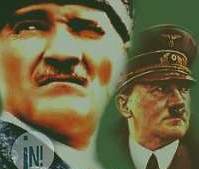ΔΕΥΤΈΡΑ, 4 ΦΕΒΡΟΥΑΡΊΟΥ 2013
Εμπνεύστηκε ο Χίτλερ από την Γενοκτονία των Αρμενίων;
Did the Armenian Genocide Inspire Hitler?
Turkey, Past and Future
 by Hannibal Travis
by Hannibal Travis
Middle East Quarterly (view PDF)
Turkey, Past and Future
 by Hannibal Travis
by Hannibal TravisMiddle East Quarterly (view PDF)
It is well known by genocide scholars that in 1939 Adolf Hitler urged his generals to exterminate members of the Polish race.[1] "Who speaks today of the extermination of the Armenians?" Hitler asked, just a week before the September 1, 1939 invasion of Poland.[2] However, while it is generally agreed that Hitler was well aware of the Armenian genocide,[3] some genocide scholars and historians of the Ottoman Empire have questioned whether he actually made the above statement or even intended to exterminate portions of the "Polish race."[4]
Still, there is evidence that the massacre of the Ottoman Armenians helped persuade the Nazis that national minorities posed a threat to empires dominated by an ethnic group such as the Germans or the Turks. Furthermore, these minorities could be exterminated to the benefit of the perpetrator with little risk. Indeed, it was German officials who had smuggled out of the Ottoman Empire the leaders of the Young Turk regime, culpable for the deaths of over a million Armenians and a million or more other Christian minorities such as the Assyrians and Greeks.[5] Diverse historical evidence suggests that Hitler viewed the Armenians and Poles as analogous; in several ways, his statement about the Armenians was consistent with his other beliefs and writings.
A number of clues point to the possibility that Hitler's "final solution" was inspired by the Turkish massacre of its Armenian population in 1915. His infamous 1939 question, "Who speaks today of the extermination of the Armenians?" although hotly debated concerning its authenticity, is only one indication leading to that conclusion.
|
The Assassin's Leak
The historical context of Hitler's statement and the manner in which it came to Western attention has long been problematic. On November 24, 1945, The Times of London published an article stating that Hitler referred to the extermination of the Armenians during an address to his commanders-in-chief on August 22, 1939, a statement that was read at a hearing of the Nuremberg trial. Hitler's speech asserted that the
aim of the war is not to attain certain lines, but consists in the physical destruction of the opponent. Thus, for the time being, I have sent to the East only my "Death's Head units" with the order to kill without pity or mercy all men, women, and children of Polish race or language. Only in such a way, will we win the vital living space that we need. Who still talks nowadays of the extermination of the Armenians?[6]
The anti-Nazi writer Louis Lochner, a former bureau chief of the Associated Press in Berlin, quoted Hitler's statement from an original Nazi document before the Nuremberg trials had even convened.[7] Lochner had a variety of sources within the Nazi government and had been interned from December 1941 to May 1942 before being exchanged for German diplomats interned in the United States. After his release, he published What about Germany?containing the quote mentioning the Armenians.[8] The quote was used in the November 1945 The Times article, which cited the ongoing proceedings of the Nuremberg trials.
Two additional copies of the memorandum describing Hitler's speech were found immediately after the war in the files of the Oberkommando der Wehrmacht (German High Command, OKW), but neither contained the Armenian quote. Nor was either military document signed as would be expected for an official record of a meeting. These incongruities led Nuremberg prosecutors to conclude that there had been two Hitler speeches on August 22 and that the Lochner version containing the quote was a merger of notes from both. As a result of the disparities, objections were made by lawyers for two Nuremberg defendants, Hermann Göring and Erich Raeder, to the authenticity of the OKW versions and to the inclusion of the Lochner document in evidence. The key issue for the defense was not the Armenian quote per se but rather the term "brutal measures," which they claimed was never used by Hitler although they conceded that he had used "severe" expressions.[9]
Since the prosecution had other records of the meetings, as well as one introduced by defendant Raeder, the Lochner document was included in the trial record but was not introduced as evidence. In the context of the Nuremberg trials, the overriding issue was not the Armenian quote but Hitler's call for a brutal war of aggression against Poland. But defenders of the Ottoman Empire regard the court's decision as key: The military versions of Hitler's speech without the quote are viewed as more reliable, and the Lochner version as suspect or tainted.[10]

